Forest School
What is a Forest School?
The Forest School Association gives us this definition,
“Forest School is an inspirational process, that offers ALL learners regular opportunities to achieve and develop confidence and self-esteem through hands-on learning experiences in a woodland or natural environment with trees.
Forest School is a specialised learning approach that sits within and complements the wider context of outdoor and woodland education.”
Guiding Principles
The six guiding Principles of Forest School set out its intentions, ethos and distinctive nature. It overlaps with other outdoor learning approaches such as bushcraft, field studies, wildlife gardening and outdoor adventurous activities, all of which may form part of Forest School sessions. The Principles are:
1. Forest School is a long-term process of regular sessions, rather than a one-off or infrequent visits; the cycle of
planning, observation, adaptation and review links each session.
2. Forest School takes place in a woodland or natural environment to support the development of a relationship
between the learner and the natural world.
3. Forest School uses a range of learner-centred processes to create a community for being, development and
learning.
4. Forest School aims to promote the holistic development of all those involved, fostering resilient, confident,
independent and creative learners.
5. Forest School offers learners the opportunity to take supported risks appropriate to the environment and to
themselves.
6. Forest School is run by qualified Forest School practitioners who continuously maintain and develop their
professional practice.
Forest School and wildlife
The second Principle of Forest School is particularly relevant to wildlife, and here are the criteria set by the UK Forest School community:
• Whilst woodland is the ideal environment for Forest School, many other sites, some with only a few trees, are
able to support good Forest School practice.
• The woodland is ideally suited to match the needs of the programme and the learners, providing them with the
space and environment in which to explore and discover.
• A Forest School programme constantly monitors its ecological impact and works within a sustainable site
management plan agreed between the landowner/ manager, the forest school practitioner and the learners.
• Forest School aims to foster a relationship with nature through regular personal experiences in order to develop
long-term, environmentally sustainable attitudes and practices in staff, learners and the wider community.
• Forest School uses natural resources for inspiration, to enable ideas and to encourage intrinsic motivation.
Many Forest School practitioners come to the role because they already have an interest in wildlife as well as in education. As part of their training, Forest School leaders learn about woodland ecology and the history and current practices of sustainable woodland management in their own area. They spend time identifying flora and fauna and consider how to introduce this skill and knowledge to their learners in informal and engaging ways which fit in with the learner-led approach.
Before starting to run their own sessions they take a close look at the site they will be using and, with guidance, assess the ecological impact of running the programme on the site. From this, they develop a three-year management plan for the sustainable use of their site. They also plan how their Forest School learners can become involved in managing the site sustainably, in ways that are appropriate to their age and abilities. So any trained Forest School leader comes to an existing or new site understanding how their activities might impact the wildlife on the site, positively or negatively. They will monitor over time and adapt their plans to enhance the site for wildlife and minimise any damage.
When a school or childcare provider starts Forest School in its own grounds, it usually involves developing a specific area. This could be a corner of the playing fields or a patch of “waste” ground which hasn’t been managed in recent times. Simply stopping mowing the grass can allow a surprising variety of wildflowers and grasses to grow, which in turn provides a wider range of habitats for invertebrates. Adding tree stumps for the fire circle and a log pile soon bring in more species, and children love seeing what’s under the log they are sitting on. Trees such as hazel, willow and dogwood are often planted as they can be used for crafts.
Before (above) and after Forest School photos of parts of Westfield Primary School's grounds
Where Forest School activities could have a negative impact on wildlife, these are identified in advance as far as possible (for example, deciding where to site a fire pit to minimise damage to soil or to the canopy of overhanging trees), or may show up in regular monitoring.
Increased footfall from children playing in mature woodland can lead to compaction of the soil and loss of species such as bluebells. One school created a “bluebell island” in their woods, where the children placed logs and signs to define an area which they would not walk on; the following year, the bluebells flowered again. On a large woodland site, Forest School activities may rotate around several smaller areas over the years to allow time for recovery.
Forest School has a significant and explicit role in developing positive attitudes to wildlife and to the wider environment in its learners (se Forest School Principles above). For many children this starts with being outside in a natural environment and having the time and encouragement to look, listen, feel, smell and sometimes (under supervision!) taste what is around them.
Sessions may start with the learners looking around them to see what has changed since they were last there – even over the course of a week, new toadstools can pop up, a tree can change colour or a path can disappear into the undergrowth. Noticing these changes invites learners to find out more; a spontaneous hunt for fungi on tree stumps armed with a magnifying glass and a camera can occupy and fascinate children.
Playing games is a favourite part of Forest School sessions, and many games involve pretending to be wild animals, moving like wild animals, or using animal senses. Granny’s Footsteps becomes fox and rabbits, blindfolded bats are guided by children making clicking sounds, and mice have to hide from owls by staying very still.
Craft activities and treasure hunts can invite learners to observe natural objects closely. Hapa Zome is the Japanese art of making leaf and flower prints on fabric by bashing them with a mallet. It's great fun and helps learners to identify plant species in an informal way.
Forest School emphasises learners using their judgement, taking supported risks, and thinking about what they are doing and why. They are encouraged to identify hazards and associated risks to themselves and other learners from their activities, and also to think about the risks to wildlife. Many children are very aware of the risks of litter to wildlife and find it satisfying to dig around in the undergrowth with litter pickers, but may not be aware of their impact on a wider range of wildlife. There is a balance between letting learners explore and direct their own learning (eg moving logs to use them as stepping stones) and protecting the site for wildlife. Involving the learners in decisions about whether to move the logs, how many to move, whether to put them back afterwards, is a big step in noticing their impact on the invertebrates which live under them and starting to care about them as part of a wider ecosystem.
So Forest School has the potential not only to enhance the wildlife value of the sites where it takes place, but also to instil in everyone who takes part a love and respect for the natural environment and an appreciation of the resources which it offers to us.
Quotes from primary school children:
“At Forest School I have learned how to be aware of my surroundings.”
“It is cool because it is kind and nice for the living nature.”
“At Forest School I have learned how to tie knots, to be careful, and to be brave. I feel calm all the time I go there.”
“I love Forest School because it’s a chance to get some fresh air and smell all the lovely smells of the woods.”
Further information:
Websites:
Forest School Association website.
Outdoor Classroom Day Resources
Page drafted by Andrea Lambert who is a Forest School Leader, edited by Steve Head
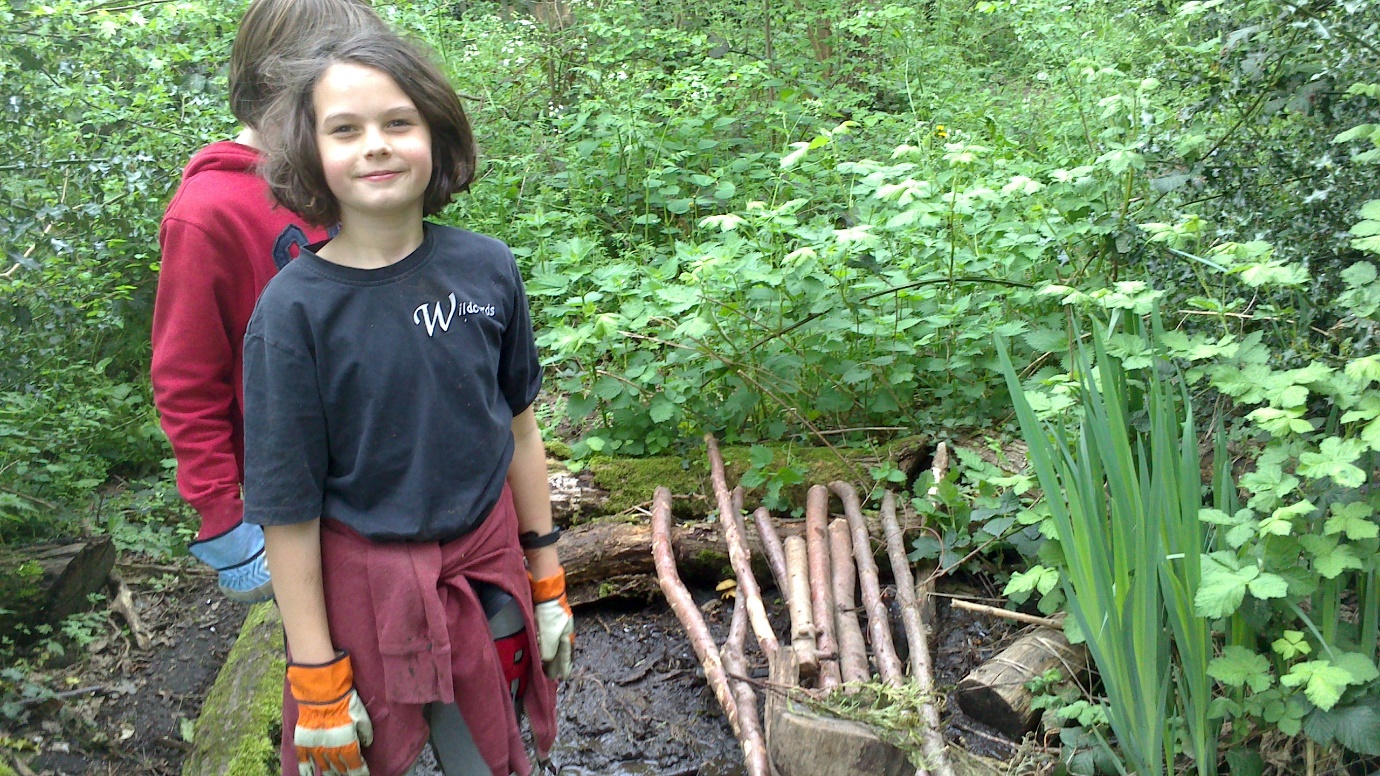
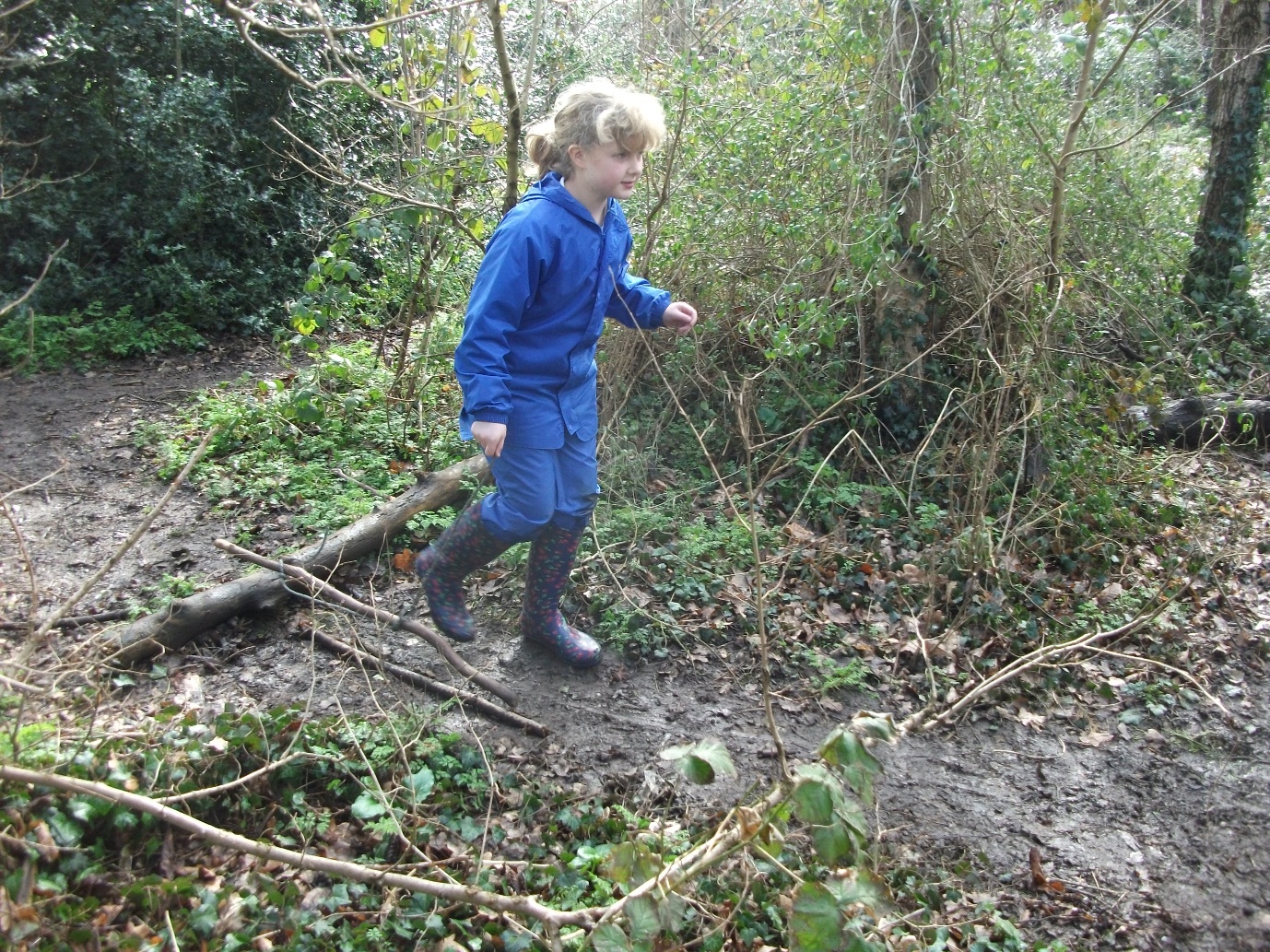
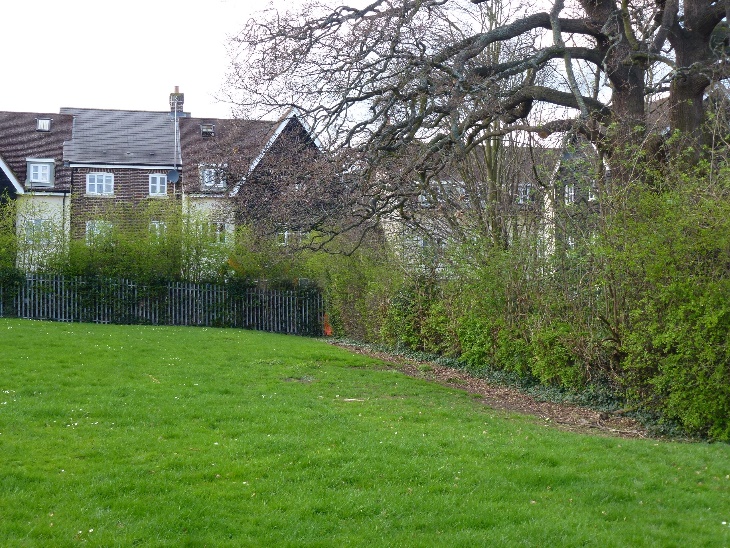
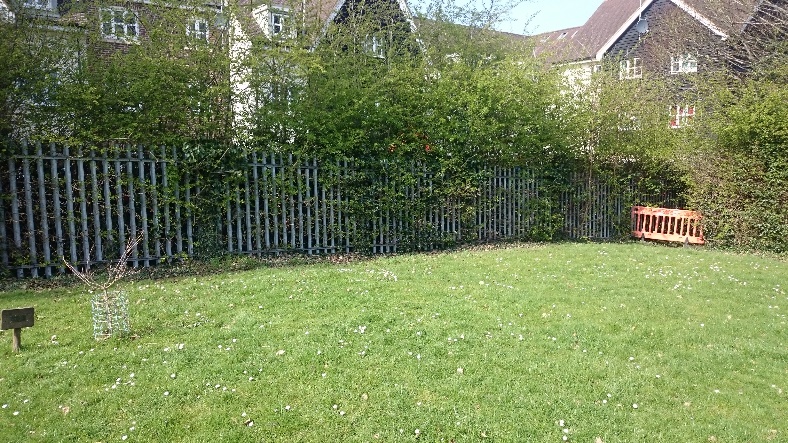

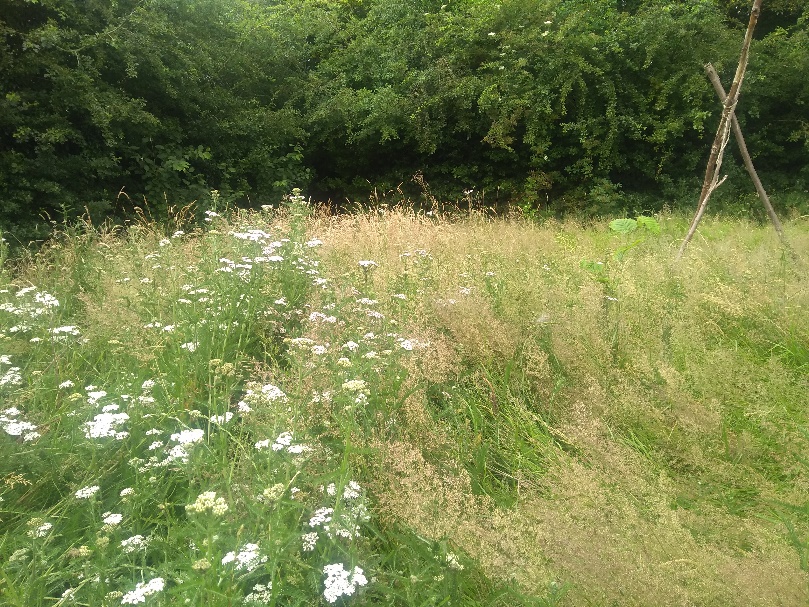
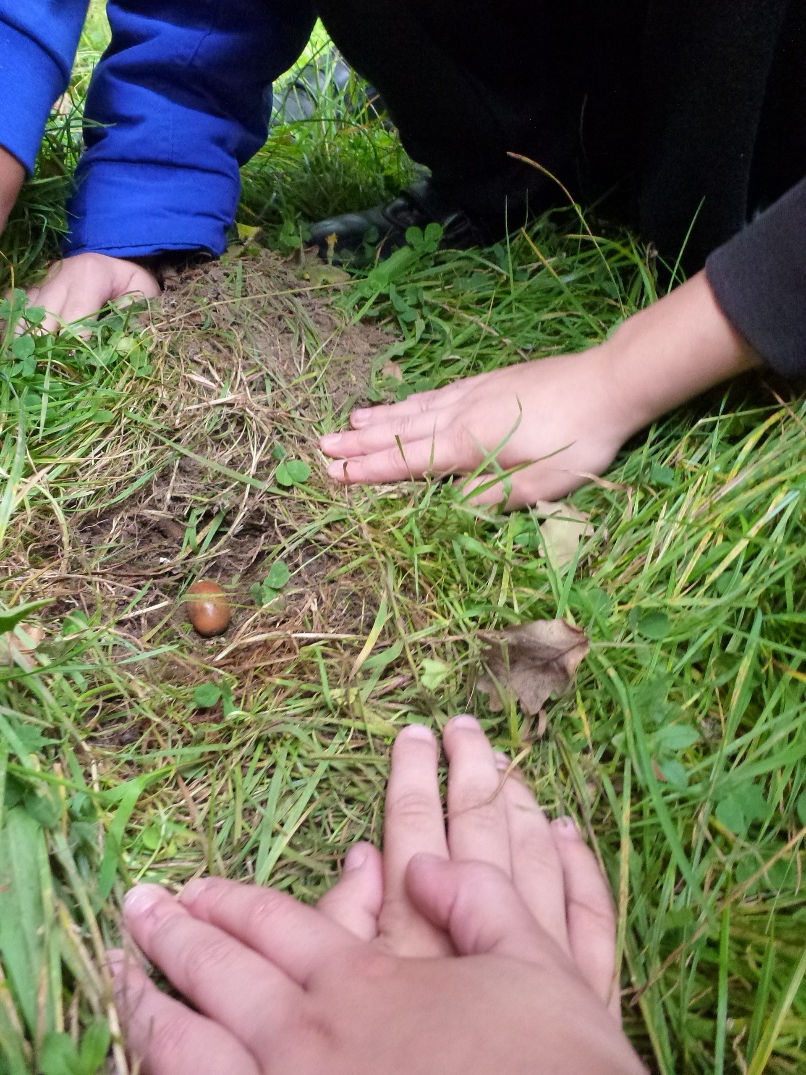
Watching a squirrel in the autumn jumping from tree to tree above their heads can raise questions of whether the squirrels were there in the summer. Why didn’t we notice them then?
This then links in to finding out more about squirrels and working out what the acorn is doing buried in a hole in the meadow?
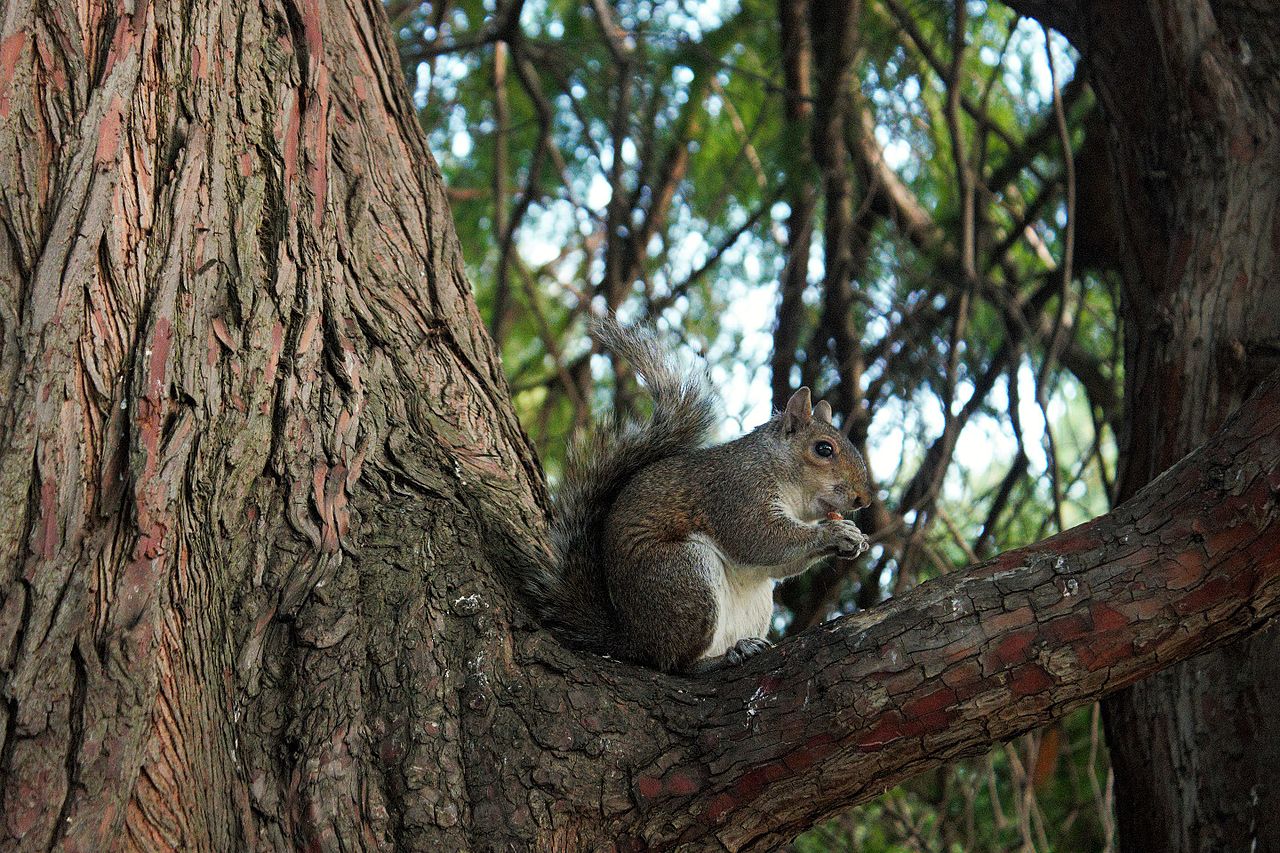
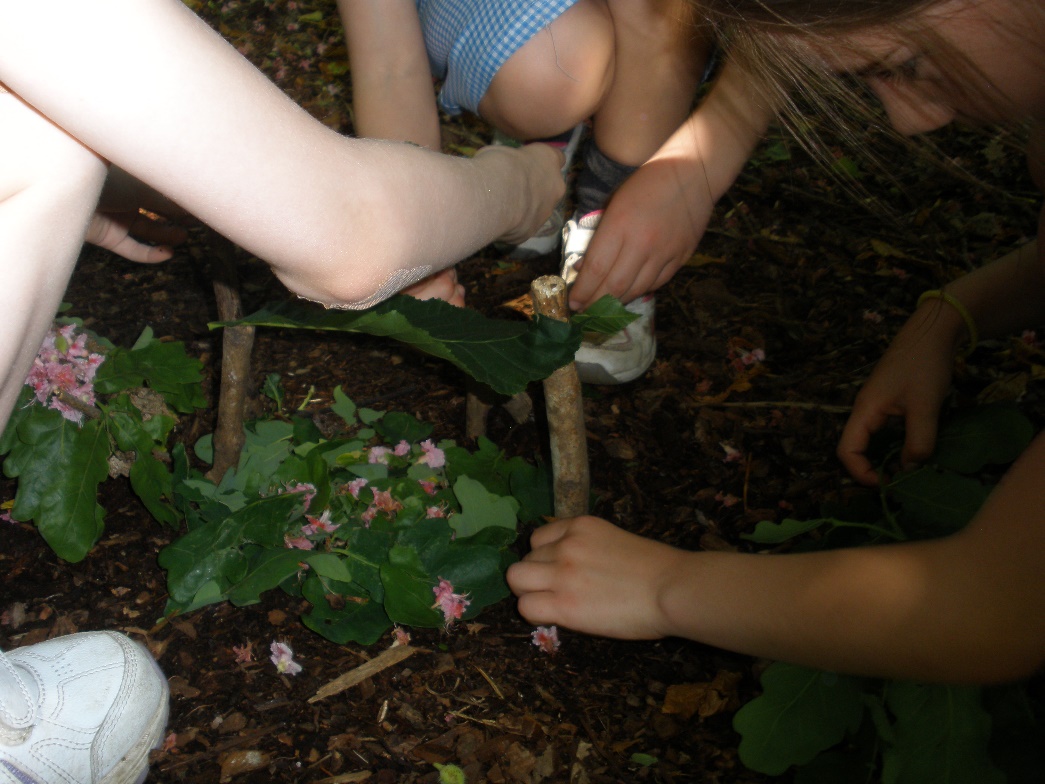
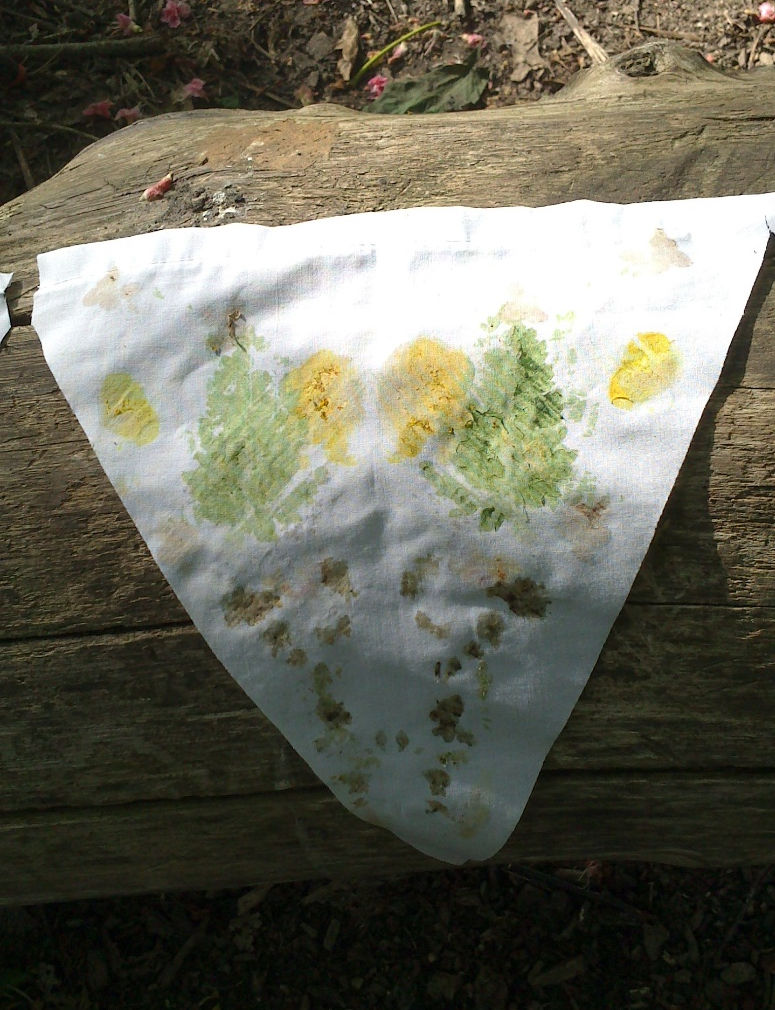
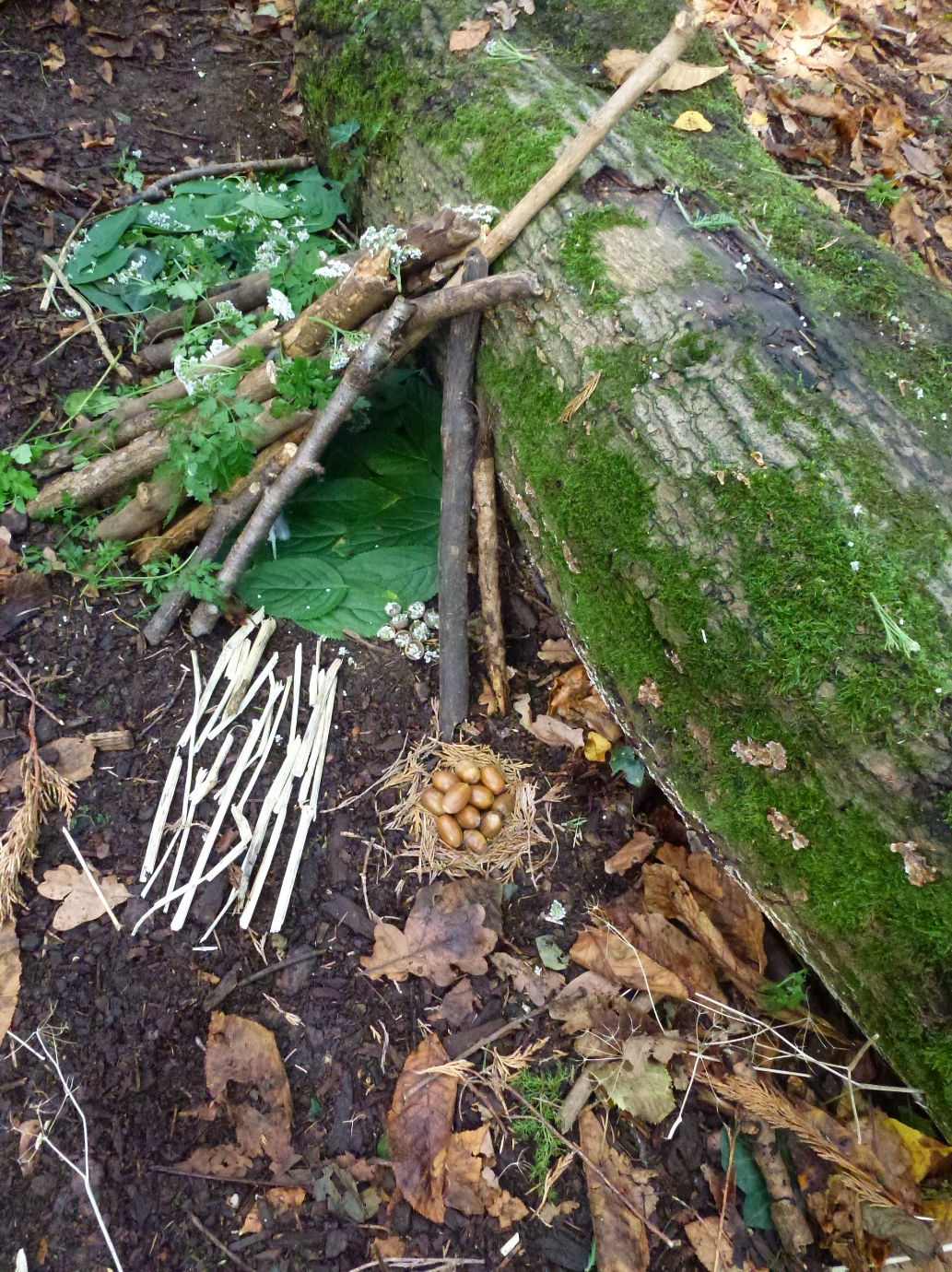
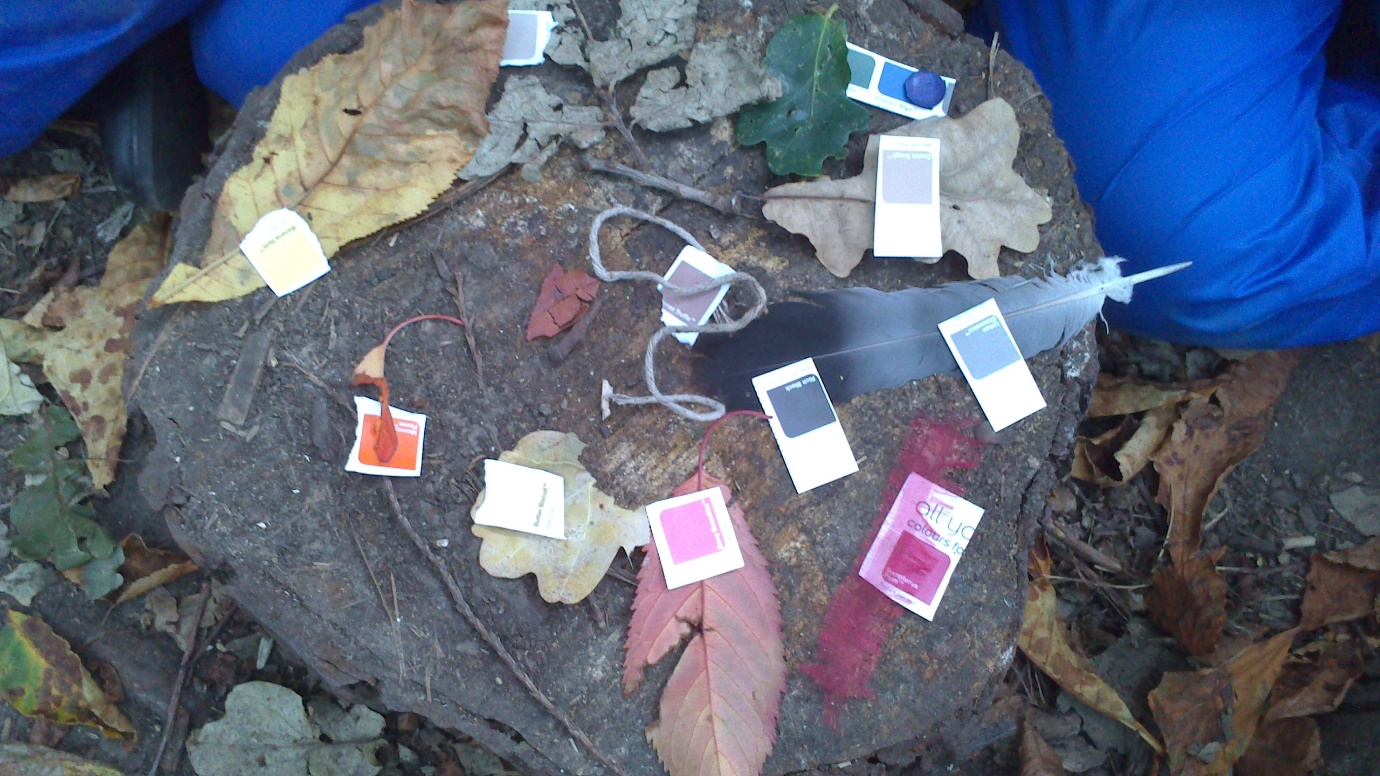
Matching colours using paint swatches shows that not all sticks are brown, and not all leaves are the same shade of green.
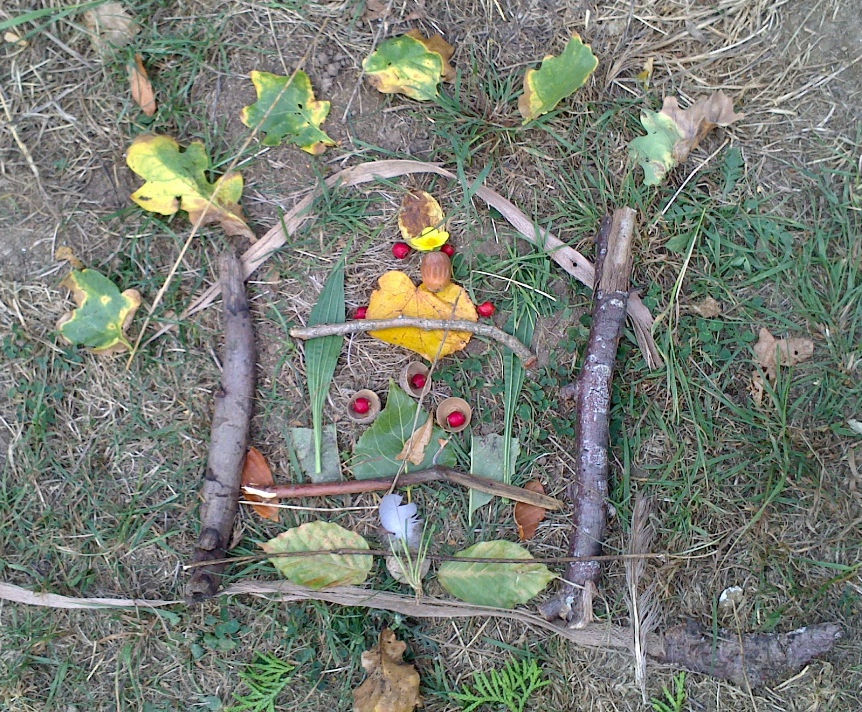
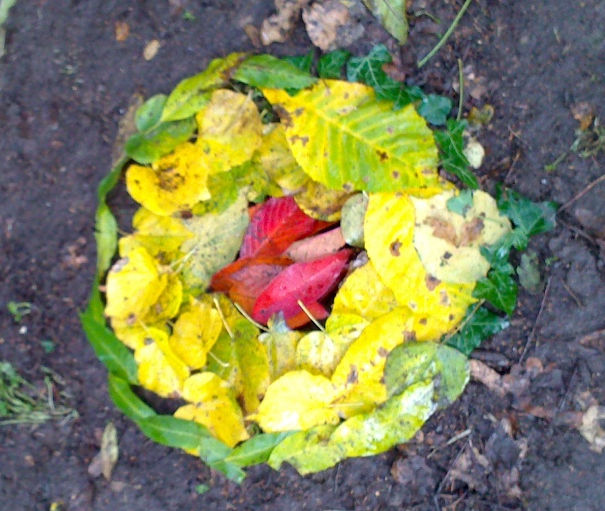
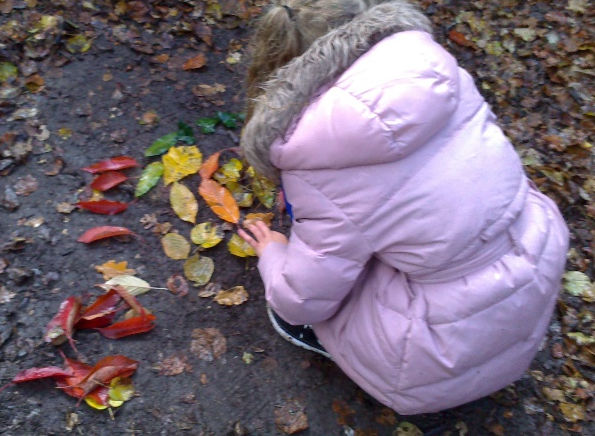
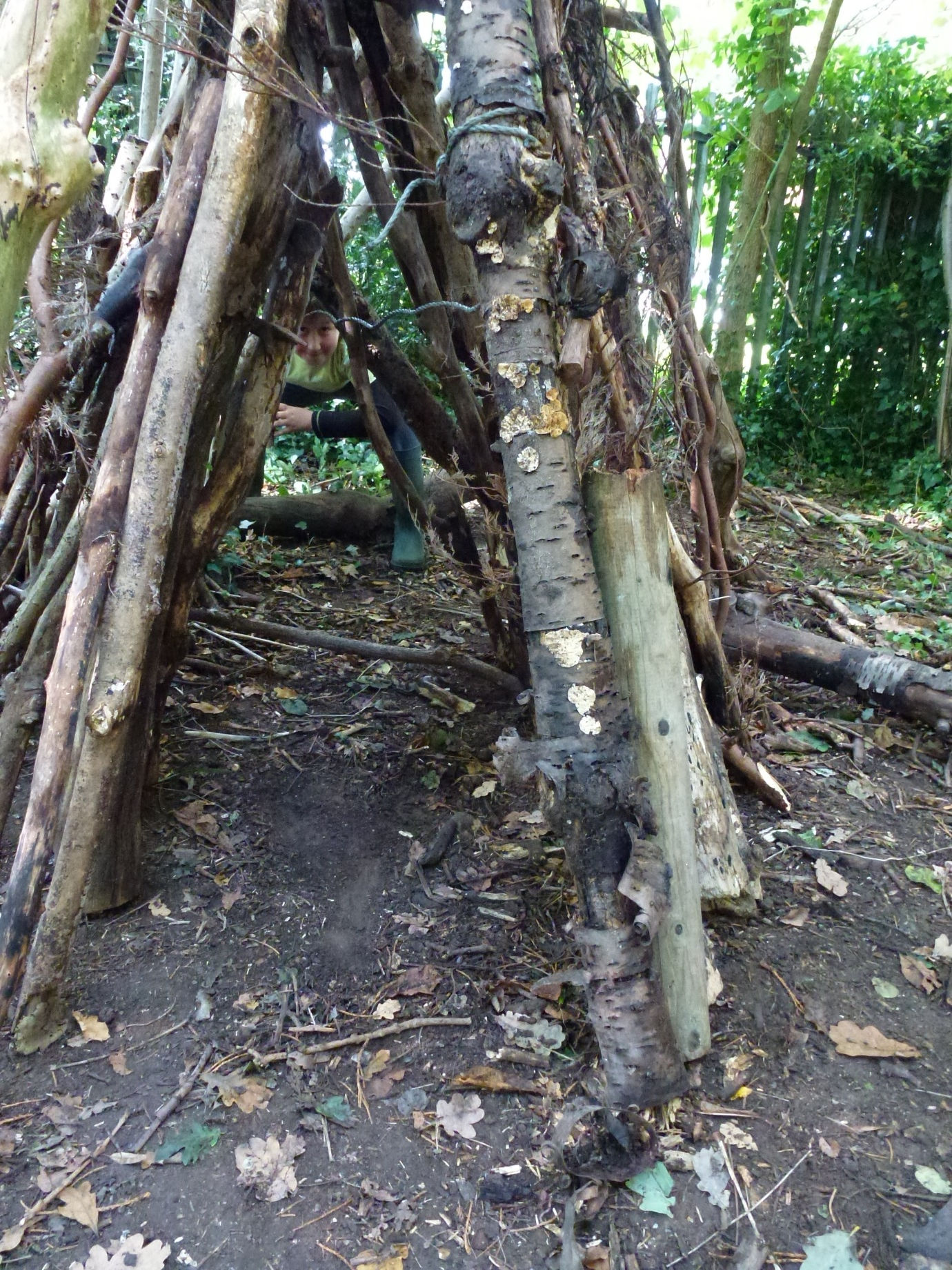
Making your own art with leaves and other found objects
Respect for wildlife increases when you appreciate its value. Swinging on a branch and breaking it might mean that you can’t build a den against it any more. Being able to identify an elder bush means that you can cut up a stem and make it into beads for a necklace, or a whistle. Talking through what type of wood you are cutting, when and why, shows the importance of taking only what you need, and what the habitat can support.
Building dens!
For fairies (far left), with green leaf carpet or bed
For real kids (left)
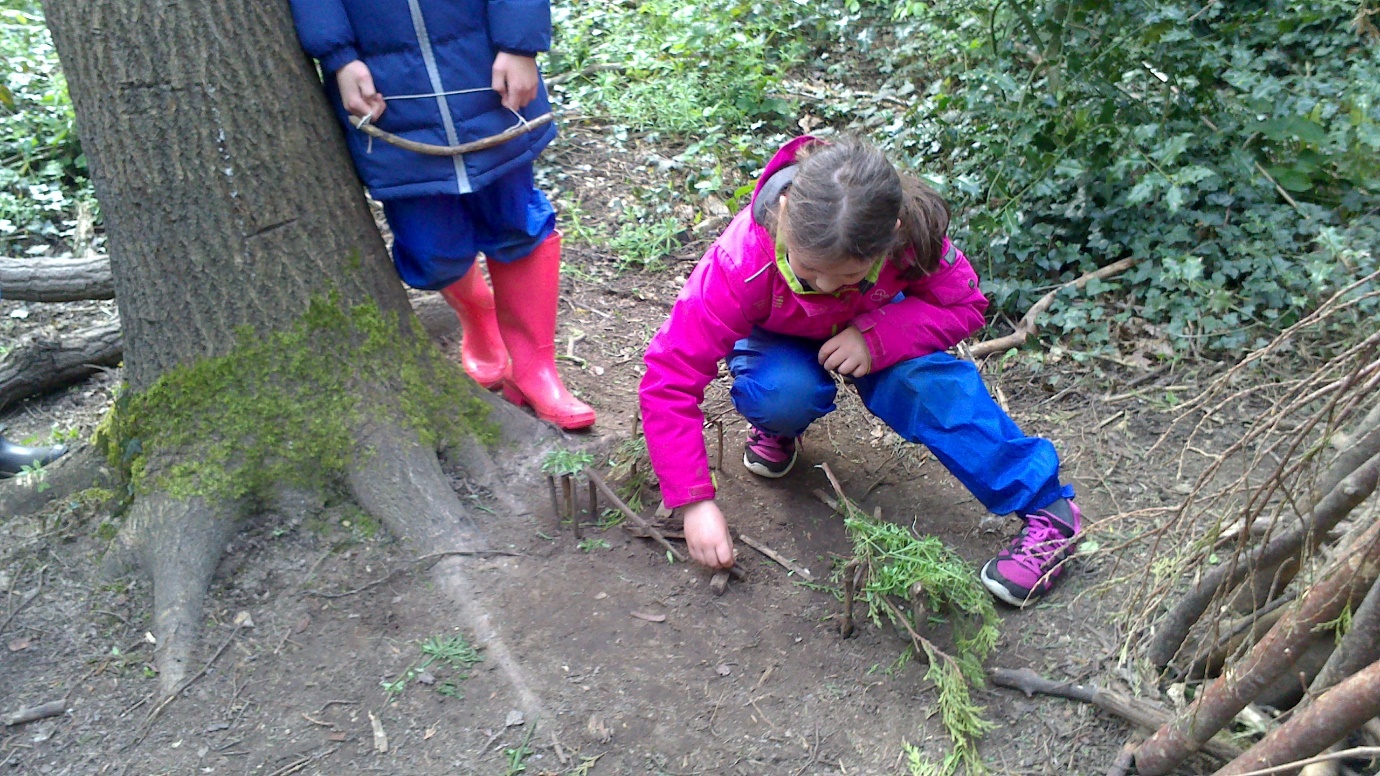
How this typically happens in practise is that small groups of learners spend most of a morning or afternoon every week in a woodland or natural setting over a couple of months or longer, all year round. During a session the learners may play games, make dens, help to care for the woodland, use tools such as hand saws and loppers, whittle sticks, make woodland art and crafts, tell or listen to stories, make fires, learn songs, and maybe just sit and enjoy being in the outdoors.
There’s often a discussion at the start on what they would like to do in the session and how they are going to keep themselves safe, and a time for reflection at the close when learners may say what they have learned, mistakes they have made, what they have found challenging, or what they are proud of.
Although sessions are led by a trained Forest School leader and other adults who play an active role in the learner’s activities, there is a great deal of freedom for the learners to choose what to do, to follow their own motivations and interests, and to direct their own play.
Sessions are most commonly run for children but there is increasing interest in Forest School for teens and adults. Participants are referred to as “learners” who range from very young children with their parents and carers, pre-school children in outdoor-based daycare, Primary school children who have daytime sessions provided at their school or who go to an after-school or holiday club, to older children or adults. Some providers focus on learners on the autistic spectrum, adults who need support with their mental health and wellbeing or others with particular challenges and needs.
History of Forest School
There were a number of early precedents for outdoor learning in the UK, but these lost way in the outcome-centred education atmosphere in the 1970s. Meanwhile, the Forest School movement started in the 1950's in Denmark and Sweden, becoming an integral part of the pre-school curriculum. The concept first came to Britain in 1993, pioneered by Bridgwater College after seeing how it had developed in Scandinavia. They set up a BTech in Forest School in 1995. The first National Conference was held in 2002. By 2006 there were about 140 forest schools established in Britain. There is a very good account of the history of Forest School available here.
Many reviews of the educational benefits of outdoor education have found Forest School to be the most effective form of outdoor learning, probably because of the duration and intensity of the experience. See our page on Education evidence, and our lengthy review of the published evidence.
- Home
- Public Benefits
- Gardens & People
- Education
- Forest School
![Photo: RMSC rochester [CC BY-SA 4.0 (https://creativecommons.org/licenses/by-sa/4.0)]](images/Forest_school image.jpg)
Forest School encourages learners to challenge themselves through learning new skills, making choices, working co-operatively and taking supported risks.
This helps them to believe in their own ability to learn and change, develop resilience and independence, make their own decisions and becoming willing to make mistakes in order to learn.
It allows them time and space to explore their thoughts, feelings and relationships as well as to explore and learn about different habitats and interactions between species at their own site, the changing seasons and the wider natural environment.
- Home
- Public Benefits
- Gardens & People
- Education
- Forest School
Forest Schools
What is a Forest School?
The Forest School Association gives us this definition,
“Forest School is an inspirational process, that offers ALL learners regular opportunities to achieve and develop confidence and self-esteem through hands-on learning experiences in a woodland or natural environment with trees.
Forest School is a specialised learning approach that sits within and complements the wider context of outdoor and woodland education.”
Forest School
What is a Forest School?
“Forest School is an inspirational process, that offers ALL learners regular opportunities to achieve and develop confidence and self-esteem through hands-on learning experiences in a woodland or natural environment with trees.
Forest School is a specialised learning approach that sits within and complements the wider context of outdoor and woodland education.”

How this typically happens in practise is that small groups of learners spend most of a morning or afternoon every week in a woodland or natural setting over a couple of months or longer, all year round. During a session the learners may play games, make dens, help to care for the woodland, use tools such as hand saws and loppers, whittle sticks, make woodland art and crafts, tell or listen to stories, make fires, learn songs, and maybe just sit and enjoy being in the outdoors.
There’s often a discussion at the start on what they would like to do in the session and how they are going to keep themselves safe, and a time for reflection at the close when learners may say what they have learned, mistakes they have made, what they have found challenging, or what they are proud of.
Although sessions are led by a trained Forest School leader and other adults who play an active role in the learner’s activities, there is a great deal of freedom for the learners to choose what to do, to follow their own motivations and interests, and to direct their own play.
Sessions are most commonly run for children but there is increasing interest in Forest School for teens and adults. Participants are referred to as “learners” who range from very young children with their parents and carers, pre-school children in outdoor-based daycare, Primary school children who have daytime sessions provided at their school or who go to an after-school or holiday club, to older children or adults. Some providers focus on learners on the autistic spectrum, adults who need support with their mental health and wellbeing or others with particular challenges and needs.
History of Forest Schools
There were a number of early precedents for outdoor learning in the UK, but these lost way in the outcome-centred education atmosphere in the 1970s. Meanwhile, the Forest School movement started in the 1950's in Denmark and Sweden, becoming an integral part of the pre-school curriculum. The concept first came to Britain in 1993, pioneered by Bridgwater College after seeing how it had developed in Scandinavia. They set up a BTech in Forest School in 1995. The first National Conference was held in 2002. By 2006 there were about 140 forest schools established in Britain. There is a very good account of the history of Forest School available here.
Many reviews of the educational benefits of outdoor education have found Forest School to be the most effective form of outdoor learning, probably because of the duration and intensity of the experience. See our page on Education evidence, and our lengthy review of the published evidence.

Guiding Principles
The six guiding Principles of Forest School set out its intentions, ethos and distinctive nature. It overlaps with other outdoor learning approaches such as bushcraft, field studies, wildlife gardening and outdoor adventurous activities, all of which may form part of Forest School sessions. The Principles are:
1. Forest School is a long-term process of regular sessions, rather than a one-off
or infrequent visits; the cycle of planning, observation, adaptation and review links each session.
2. Forest School takes place in a woodland or natural environment to support the development of a relationship between the learner and the natural world.
3. Forest School uses a range of learner-centred processes to create a
community for being, development and learning.
4. Forest School aims to promote the holistic development of all those involved,
fostering resilient, confident, independent and creative learners.
5. Forest School offers learners the opportunity to take supported risks
appropriate to the environment and to themselves.
6. Forest School is run by qualified Forest School practitioners who continuously
maintain and develop their professional practice.
![Photo: RMSC rochester [CC BY-SA 4.0 (https://creativecommons.org/licenses/by-sa/4.0)]](images/Forest_school image.jpg)
Forest School encourages learners to challenge themselves through learning new skills, making choices, working co-operatively and taking supported risks.
This helps them to believe in their own ability to learn and change, develop resilience and independence, make their own decisions and becoming willing to make mistakes in order to learn.
It allows them time and space to explore their thoughts, feelings and relationships as well as to explore and learn about different habitats and interactions between species at their own site, the changing seasons and the wider natural environment.
Forest School and wildlife
The second Principle of Forest School is particularly relevant to wildlife, and here are the criteria set by the UK Forest School community:
• Whilst woodland is the ideal environment for Forest School, many other sites,
some with only a few trees, are able to support good Forest School practice.
• The woodland is ideally suited to match the needs of the programme and the
learners, providing them with the space and environment in which to explore
and discover.
• A Forest School programme constantly monitors its ecological impact and works
within a sustainable site management plan agreed between the landowner/
manager, the forest school practitioner and the learners.
• Forest School aims to foster a relationship with nature through regular personal
experiences in order to develop long-term, environmentally sustainable
attitudes and practices in staff, learners and the wider community.
• Forest School uses natural resources for inspiration, to enable ideas and to
encourage intrinsic motivation.
Many Forest School practitioners come to the role because they already have an interest in wildlife as well as in education. As part of their training, Forest School leaders learn about woodland ecology and the history and current practices of sustainable woodland management in their own area. They spend time identifying flora and fauna and consider how to introduce this skill and knowledge to their learners in informal and engaging ways which fit in with the learner-led approach.
Before starting to run their own sessions they take a close look at the site they will be using and, with guidance, assess the ecological impact of running the programme on the site. From this, they develop a three-year management plan for the sustainable use of their site. They also plan how their Forest School learners can become involved in managing the site sustainably, in ways that are appropriate to their age and abilities. So any trained Forest School leader comes to an existing or new site understanding how their activities might impact the wildlife on the site, positively or negatively. They will monitor over time and adapt their plans to enhance the site for wildlife and minimise any damage.
When a school or childcare provider starts Forest School in its own grounds, it usually involves developing a specific area. This could be a corner of the playing fields or a patch of “waste” ground which hasn’t been managed in recent times. Simply stopping mowing the grass can allow a surprising variety of wildflowers and grasses to grow, which in turn provides a wider range of habitats for invertebrates. Adding tree stumps for the fire circle and a log pile soon bring in more species, and children love seeing what’s under the log they are sitting on. Trees such as hazel, willow and dogwood are often planted as they can be used for crafts.







Before (above) and after Forest School photos of parts of Westfield Primary School's grounds
Where Forest School activities could have a negative impact on wildlife, these are identified in advance as far as possible (for example, deciding where to site a fire pit to minimise damage to soil or to the canopy of overhanging trees), or may show up in regular monitoring.
Increased footfall from children playing in mature woodland can lead to compaction of the soil and loss of species such as bluebells. One school created a “bluebell island” in their woods, where the children placed logs and signs to define an area which they would not walk on; the following year, the bluebells flowered again. On a large woodland site, Forest School activities may rotate around several smaller areas over the years to allow time for recovery.
Forest School has a significant and explicit role in developing positive attitudes to wildlife and to the wider environment in its learners (se Forest School Principles above). For many children this starts with being outside in a natural environment and having the time and encouragement to look, listen, feel, smell and sometimes (under supervision!) taste what is around them.
Sessions may start with the learners looking around them to see what has changed since they were last there – even over the course of a week, new toadstools can pop up, a tree can change colour or a path can disappear into the undergrowth. Noticing these changes invites learners to find out more; a spontaneous hunt for fungi on tree stumps armed with a magnifying glass and a camera can occupy and fascinate children.
Playing games is a favourite part of Forest School sessions, and many games involve pretending to be wild animals, moving like wild animals, or using animal senses. Granny’s Footsteps becomes fox and rabbits, blindfolded bats are guided by children making clicking sounds, and mice have to hide from owls by staying very still.
Craft activities and treasure hunts can invite learners to observe natural objects closely. Hapa Zome is the Japanese art of making leaf and flower prints on fabric by bashing them with a mallet. It's great fun and helps learners to identify plant species in an informal way.
Matching colours using paint swatches shows that not all sticks are brown, and not all leaves are the same shade of green.


Watching a squirrel in the autumn jumping from tree to tree above their heads can raise questions of whether the squirrels were there in the summer. Why didn’t we notice them then?
This then links in to finding out more about squirrels and working out what the acorn is doing buried in a hole in the meadow?
Making your own art with leaves and other found objects



Building dens!
For fairies (far left), with green leaf carpet or bed
For real kids (left)


Respect for wildlife increases when you appreciate its value. Swinging on a branch and breaking it might mean that you can’t build a den against it any more. Being able to identify an elder bush means that you can cut up a stem and make it into beads for a necklace, or a whistle. Talking through what type of wood you are cutting, when and why, shows the importance of taking only what you need, and what the habitat can support.
Forest School emphasises learners using their judgement, taking supported risks, and thinking about what they are doing and why. They are encouraged to identify hazards and associated risks to themselves and other learners from their activities, and also to think about the risks to wildlife. Many children are very aware of the risks of litter to wildlife and find it satisfying to dig around in the undergrowth with litter pickers, but may not be aware of their impact on a wider range of wildlife. There is a balance between letting learners explore and direct their own learning (eg moving logs to use them as stepping stones) and protecting the site for wildlife. Involving the learners in decisions about whether to move the logs, how many to move, whether to put them back afterwards, is a big step in noticing their impact on the invertebrates which live under them and starting to care about them as part of a wider ecosystem.

So Forest School has the potential not only to enhance the wildlife value of the sites where it takes place, but also to instil in everyone who takes part a love and respect for the natural environment and an appreciation of the resources which it offers to us.
Quotes from primary school children:
“At Forest School I have learned how to be aware of my surroundings.”
“It is cool because it is kind and nice for the living nature.”
“At Forest School I have learned how to tie knots, to be careful, and to be brave. I feel calm all the time I go there.”
“I love Forest School because it’s a chance to get some fresh air and smell all the lovely smells of the woods.”
Further information:
Websites:
Outdoor Classroom Day Resources
Page drafted by Andrea Lambert who is a Forest School Leader, edited by Steve Head


|
|
|
|
|
| Introduction to Garden Science | ||
| Garden Ecology | ||
| Garden Biodiversity | ||
| History of gardens and wildlife | ||
| Finding out more | ||
| Wildlife Gardening Myths |
| Introduction to Garden Ecology | ||
| Gardens as a resource | ||
| Physical environment | ||
| Foodwebs and feeding roles | ||
| Climate change | ||
| Sheffield BUGS project | ||
| Plants for Bugs Project | ||
| Research needs | ||
| Garden surveys | ||
| Garden soils |
| Introduction to Garden Biodiversity | ||
| How many species in gardens? | ||
| Native and non-native issues | ||
| Gardens and conservation |
| Introduction to Finding out more | ||
| Natural England booklets | ||
| Books and websites | ||
| Specialist societies | ||
| Scientific literature | ||
| Facebook groups |
| Introduction | ||
| "How to" guides | ||
| Garden Habitats | ||
| Plants and planting | ||
| Garden management |
| Introduction | ||
| Adapt your garden | ||
| Help wildlife groups | ||
| Work with plants | ||
| Make habitats | ||
| Garden sustainability | ||
| Garden with others | ||
| Tips for yourself |
| Introduction to garden habitats | ||
| Water habitats | ||
| Hugelkultur |
| Water and pond ecology | ||
| Ponds and conservation | ||
| Creating garden ponds | ||
| Planting-up ponds | ||
| Managing ponds |
| Planting: basic principles | ||
| Native or non-native? | ||
| Planting for structure | ||
| Planting for pollinators | ||
| Planting for herbivores | ||
| Plants to avoid | ||
| Companion planting |
| Introduction | ||
| Garden design | ||
| Compost and fertility | ||
| Managing pests and diseases | ||
| Gardening without peat | ||
| Garden products | ||
| Tidiness and wildlife |
| Introduction | ||
| Gardens and people | ||
| Urban gardens | ||
| Garden businesses |
| Introduction | ||
| Attitude Survey 2020 | ||
| Wildlife gardens and Education |
| Introduction | ||
| Education resources | ||
| Education evidence | ||
| Case studies | ||
| School grounds | ||
| Forest School |
| Introduction |
| Introduction | ||
| Business grounds |
| Saïd School | ||
| Cemex factory |










